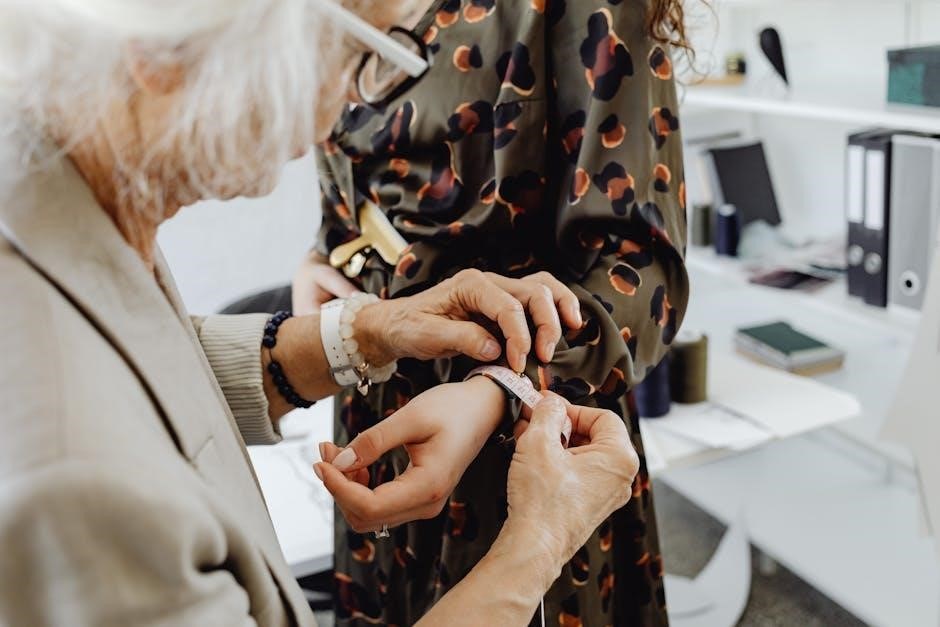
Importance of Body Measurements in Sewing
Accurate body measurements are essential for creating garments that fit perfectly, ensuring both comfort and confidence. They enable personalized clothing that flatters your unique shape and size, making sewing more enjoyable and successful. PDF body measurement charts provide a clear, organized way to record and track your measurements, helping you achieve professional results in your sewing projects.
Why Accurate Measurements Matter for Garment Fit
Accurate body measurements are vital for achieving a perfect garment fit. Incorrect measurements can lead to discomfort, poor appearance, or the need for costly alterations. By ensuring precision, you can create clothes that flatter your body, boost confidence, and meet your personal style goals. Reliable data also helps in selecting the right patterns and making necessary adjustments for a seamless fit.
How Body Measurements Ensure Personalized Clothing
Body measurements allow for custom-fit garments tailored to your unique physique. By recording specific details like bust, waist, and hip sizes, you can adjust patterns to suit your body perfectly. This ensures clothes that not only fit well but also enhance your natural shape. Personalized clothing boosts confidence and comfort, making every sewing project a success. Using a PDF body measurement chart streamlines this process, ensuring accuracy and ease.

Key Measurements for Sewing
Key sewing measurements include bust, waist, hip, inseam, and sleeve length. These ensure a proper fit and are crucial for garment construction. Additional measurements like neckline and armhole depth provide a more tailored fit. A PDF body measurement chart helps organize these details effectively.
Bust, Waist, and Hip Measurements
Bust, waist, and hip measurements are foundational for garment fit. The bust measures around the fullest part of the chest, the waist at the narrowest point, and the hips 7-9 inches below the waist. These measurements help determine pattern sizes and ensure a proper fit. They are essential for creating a flattering silhouette and are often the primary focus when using a body measurement chart for sewing PDF to guide your projects.
Additional Measurements: Inseam, Sleeve Length, and More
While bust, waist, and hip measurements are key, other measurements like inseam (pant length), sleeve length (from shoulder to wrist), and neckline depth are equally important. These ensure proper fit for specific garments, such as pants, shirts, and dresses. Including these in your body measurement chart for sewing PDF allows for customization and accuracy, ensuring your projects fit perfectly and meet your needs.
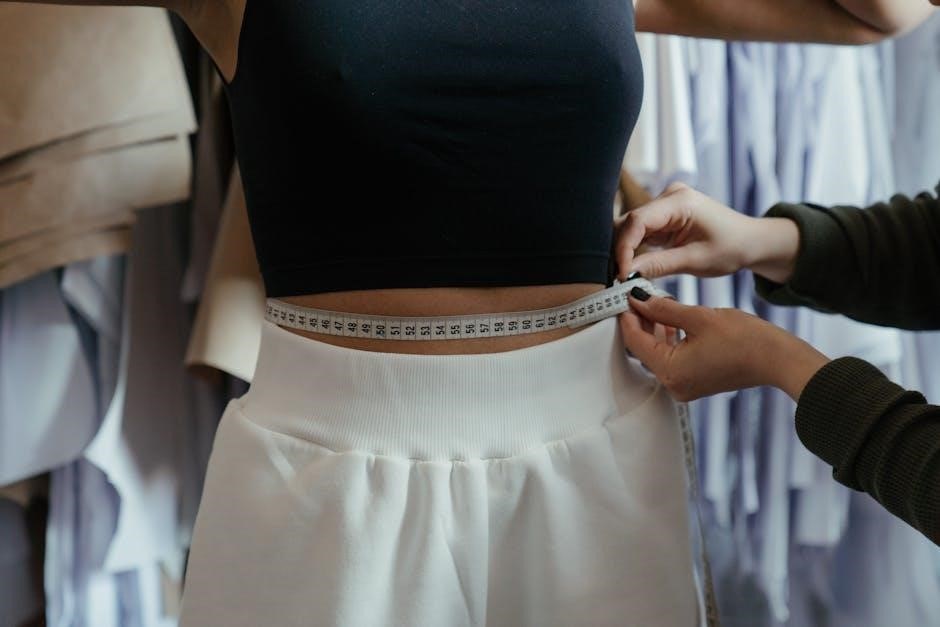
Tools for Recording Measurements
Printable body measurement charts in PDF format and customizable templates are essential tools for accurately recording and organizing your measurements. These resources ensure precision and convenience for sewing projects.
Printable Body Measurement Charts in PDF Format
Printable body measurement charts in PDF format are indispensable for sewists, offering a structured way to record bust, waist, and hip measurements. Available in A4 or US Letter sizes, these charts are customizable, allowing users to edit fonts, colors, and text; They provide a user-friendly tool for tracking fitness goals and sewing projects, ensuring accuracy and organization. Downloadable and shareable, they simplify the measuring process for both personal and professional use.
Customizable Templates for Sewing and Tailoring
Customizable templates for sewing and tailoring offer flexibility and convenience, allowing users to tailor measurement charts to their specific needs. With features like click-and-drag editing, these templates enable easy customization of fonts, colors, and text. Perfect for both personal projects and professional tailoring businesses, they provide a professional and organized way to record client or personal measurements, ensuring precise-fit garments and efficient workflow.
How to Choose the Right Sewing Pattern
Choosing the right sewing pattern involves comparing your body measurements to the pattern’s size chart to ensure a perfect fit. Accurate measurements guarantee a flattering result.
Understanding Pattern Size Charts
Pattern size charts are essential guides for selecting the correct sewing pattern. They typically include measurements for bust, waist, and hips, which are crucial for ensuring a proper fit. These charts may also include finished garment measurements, which differ from body measurements. By referencing a body measurement chart for sewing PDF, you can accurately match your measurements to the pattern size, ensuring a well-fitting garment. Always check if the chart includes height, as this can affect the fit of certain patterns. This step is vital for achieving professional-looking results and avoiding costly alterations.
Matching Body Measurements to Pattern Sizes
Matching body measurements to pattern sizes is crucial for achieving a perfect fit. Compare your recorded measurements with the pattern’s size chart, focusing on bust, waist, and hip measurements. Use a body measurement chart for sewing PDF to ensure accuracy. Patterns may require blending sizes if your measurements fall into multiple categories. Always double-check the fit before cutting fabric to avoid alterations and ensure a professional finish.
Drafting Patterns Based on Measurements
Drafting patterns from body measurements ensures a perfect fit. Start by creating a personalized body block or sloper using your measurements. This serves as a foundation for designing custom garments, allowing you to make precise adjustments for a flattering fit. Use your recorded measurements from a body measurement chart for sewing PDF to guide the drafting process accurately.
Creating a Personalized Body Block
A personalized body block, or sloper, is a custom-fit template created from your measurements. It serves as the foundation for all sewing patterns, ensuring a perfect fit. Using a body measurement chart for sewing PDF, you can accurately draft a block that reflects your unique proportions. This step is crucial for achieving professional results and allows for endless customization in garment design. It streamlines the sewing process, making pattern adjustments effortless and precise.
Step-by-Step Guide to Drafting Basic Patterns
Drafting basic patterns begins with your body measurements. Start by transferring your measurements to a body block, ensuring accuracy for a perfect fit. Use your bust, waist, and hip measurements to outline the shape; Add ease allowances for comfort and movement. Next, incorporate hem and seam allowances. Calculate sleeve and inseam lengths for completeness. This method ensures patterns align with your body, making sewing efficient and enjoyable; Accuracy in each step guarantees professional results.
Measurement Guides for Specific Needs
Measurement guides cater to specific needs, offering charts for kids and adults with varying sizes. Home decor projects require precise measurements for items like curtains and upholstery, ensuring proper fit. Using downloadable PDFs allows for easy customization and accurate tracking of measurements, ensuring professional results in sewing and tailoring.
Measurement Charts for Kids and Adults
Body measurement charts are available for both kids and adults, ensuring accurate sizing for all ages. Charts for children include sizes for babies, toddlers, and older kids, while adult charts provide detailed measurements for men and women. These PDF charts are customizable, allowing you to track growth and create well-fitting garments. They also offer clear guidelines for measuring specific areas, ensuring precise and professional results in sewing projects for every family member.
Measuring for Home Decor Projects
Measuring for home decor sewing requires precision to ensure a perfect fit. Accurate window measurements are crucial for curtains, while fabric requirements depend on the project’s size. Use a PDF measurement guide to track dimensions for upholstery, tablecloths, or pillow covers. Record measurements clearly to avoid errors, ensuring your home decor creations fit seamlessly and enhance your space beautifully. Proper planning leads to professional-looking results.
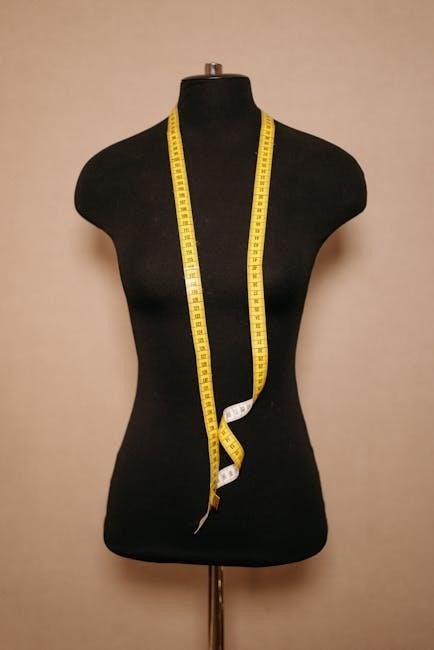
Tips for Accurate Measuring
Use a flexible tape measure, keep it level, and avoid pulling it too tight. Measure over the same undergarments and clothing for consistency. Take multiple measurements to ensure accuracy for the best fit. A partner can help achieve precise results.
Best Practices for Taking Body Measurements
Use a flexible tape measure and ensure it’s level for accurate results. Wear snug-fitting clothing or undergarments for consistency. Stand up straight and relax your posture. Measure multiple times to confirm accuracy. Record measurements in a PDF body measurement chart for easy reference. Consider enlisting a partner for hard-to-reach areas. Avoid pulling the tape too tight or loosely, as this can skew results. Consistency is key to achieving the best fit.
How to Ensure Consistency in Measurements
Consistency in measurements is key to achieving accurate results. Always use a flexible tape measure and measure in the same anatomical locations. Wear snug, form-fitting clothing and stand upright. Record measurements multiple times and average them for reliability. Use a partner for hard-to-reach areas. Maintain a routine for measuring, such as at the same time of day. Store results in a PDF body measurement chart for easy reference and review.
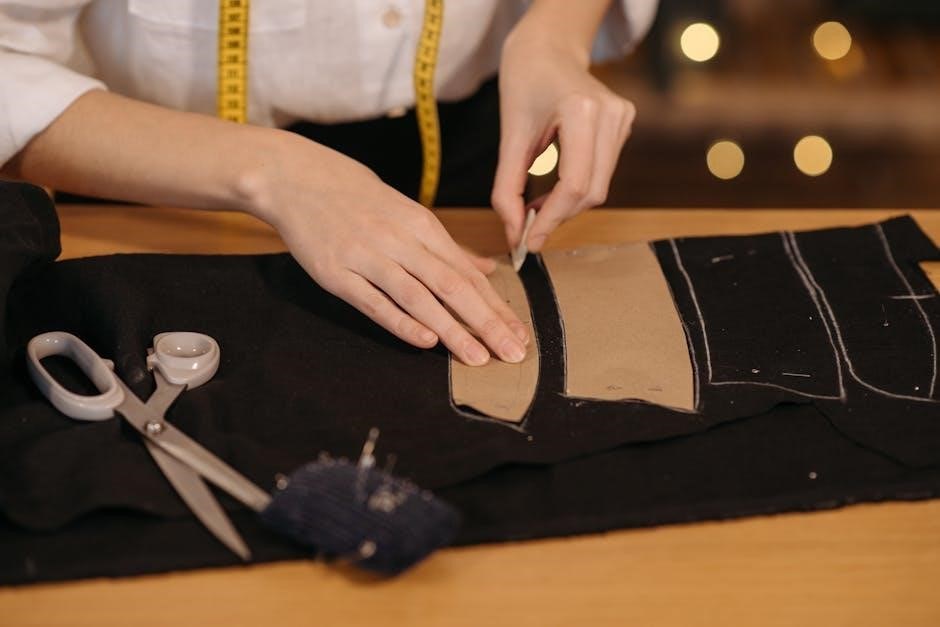
Using Digital Tools for Measurements
Digital tools simplify measuring with online platforms like Tailornova and apps offering customizable charts. PDF body measurement charts can be edited and downloaded instantly, ensuring precision and efficiency for sewists.
Online Platforms for Creating and Editing Measurement Charts
Online platforms like Tailornova and Sew Liberated offer digital tools for creating and editing body measurement charts. These platforms allow users to input their measurements and generate customizable PDF charts. Editable templates enable sewists to track changes and share charts easily. Advanced features include click-and-drag customization and the ability to download charts in multiple formats, making sewing projects more efficient and precise. Digital tools enhance accuracy and streamline the measuring process.
How Technology is Changing Sewing Measurements
Technology is revolutionizing sewing measurements through digital tools and AI. Platforms like Tailornova offer customizable PDF charts, while apps enable 3D avatars for virtual try-ons. These innovations allow sewists to input measurements and generate precise patterns, enhancing accuracy and efficiency. Technology streamlines the process, making it easier to achieve perfect fits and explore creative possibilities in garment creation.

Common Mistakes to Avoid
Common errors include inaccurate measurements, ignoring ease allowances, and mismatching body sizes with patterns. Always double-check measurements and use proper tools to ensure a perfect fit and avoid costly mistakes.
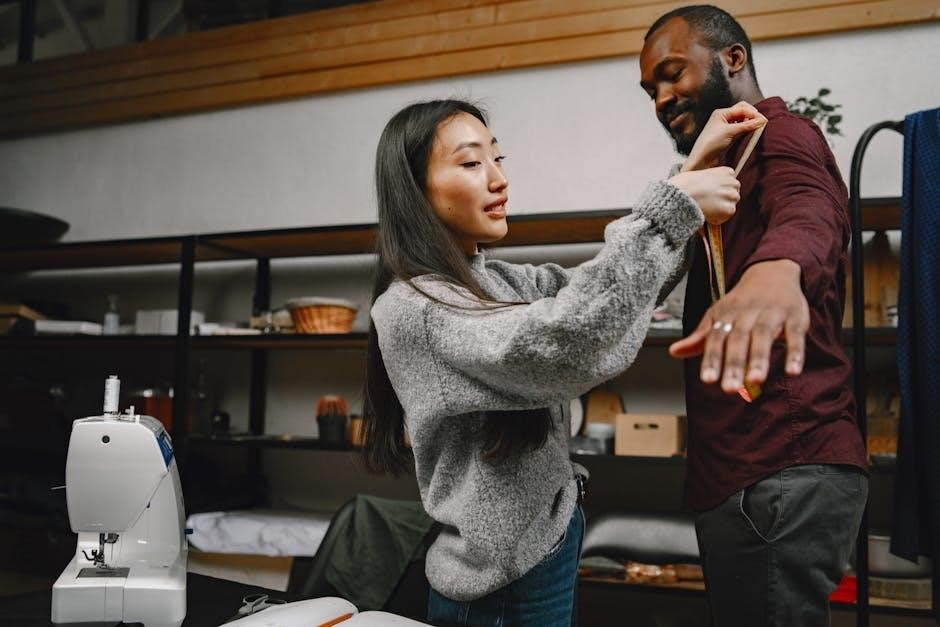
Pitfalls in Measuring and Pattern Selection
One common mistake is taking inaccurate measurements, often due to improper positioning of the tape measure or not accounting for ease. Another pitfall is selecting patterns based on finished garment sizes rather than body measurements, leading to poor fit. Additionally, ignoring height adjustments or not re-measuring regularly can result in ill-fitting clothes. Always use reliable charts and double-check data to avoid these errors.
How to Correctly Interpret Measurement Data
Interpreting measurement data accurately ensures garments fit well. Match your measurements to pattern size charts, considering bust, waist, and hip proportions. Factor in ease allowances and height adjustments for optimal fit. Use reliable charts and cross-reference measurements to avoid discrepancies. Stay organized by documenting changes and updates to your measurements for future projects, ensuring consistent and professional sewing results every time.
Future of Body Measurement Charts
The future of body measurement charts lies in AI-powered apps and 3D avatars, offering precise fits and personalized sewing patterns with minimal effort required.
Advancements in Digital Measurement Tools
Digital tools are revolutionizing sewing by providing precise and customizable measurement solutions. Online platforms now offer AI-powered apps that create detailed body avatars, enabling accurate fabric draping simulations. These tools allow sewists to input measurements and generate perfect-fit patterns instantly. Additionally, 3D scanning technology is emerging, offering a futuristic way to capture body dimensions without tape measures. Such innovations are making sewing more accessible and efficient for all skill levels.
How AI and Apps are Transforming Sewing Measurements
AI-powered apps are transforming sewing by enabling precise measurements through digital avatars and 3D scanning. These tools generate accurate patterns and provide real-time adjustments, ensuring a perfect fit. Apps also offer customizable templates and fabric simulations, making sewing more accessible and efficient. With AI, sewists can achieve professional results effortlessly, while innovative features like error detection and fabric type adjustments further enhance the sewing experience.